Prior to the ongoing counteroffensive in the Zaporizhzhia Oblast, Ukraine launched a series of counterattacks in the Donetsk Oblast, south and north of Bakhmut. Despite its little tactical and strategic importance for both sides, Bakhmut became the longest and bloodiest siege of the Russian all-out war against Ukraine.
The battle for this emblematic Ukrainian stronghold started in August 2022 and lasted more than nine months before the Russian army captured the town in May 2023. Russia invested a lot of effort and suffered heavy casualties to capture Bakhmut and, therefore, cannot afford to lose it without a fight.
Although Ukrainian counterattacks in the Bakhmut sector are hardly the main effort of the ongoing counteroffensive, they are an essential part of it. Ukraine gradually increased pressure on the flanks around Bakhmut, threatening to encircle the town and pinning a significant number of Russian forces in this area.
Ukrainian attempts to create a bridgehead on the eastern bank of the Dnipro River in occupied Kherson Oblast is another twist that may change the course of the counteroffensive dramatically if Russia pays no attention to it.
Meanwhile, Russia tries to distract Ukrainian forces with attacks near Kupiansk (Kharkiv Oblast, eastern Ukraine), Kreminna (Luhansk Oblast, eastern Ukraine), Mariinka, and Avdiivka (both in Donetsk Oblast, eastern Ukraine). These are the only areas in Ukraine where the Russian army still goes on the offensive.
However, the main fighting is taking place in the Zaporizhzhia Oblast, where the Ukrainian army is slowly but steadily grinding forward. Ukraine has a strategic initiative along almost the entire front line, stretching over 1,200 kilometers.
What is wrong with the Ukrainian counteroffensive?
In his latest interview with the Washington Post, the Commander-in-Chief of Ukraine’s Armed Forces, General Valerii Zaluzhnyi, was critical of counterparts who had argued that Ukraine would not need F-16 fighter jets to succeed. Western militaries would never fight without fighter jets, Zaluzhnyi said.
During the Gulf War of 1990-1991, the coalition of 39 countries led by the United States fought against Iraq in a way that Ukraine could only dream of. The coalition's offensive started only after an extensive aerial bombing campaign lasting 36 days (from 17 January 1991 to 23 February 1991).
The coalition used fighter jets, bombers, and cruise missiles to attrition Iraqi forces and disrupt their ground lines of communication. The air forces of the coalition flew 109,876 sorties, launched 288 Tomahawk missiles, and dropped 88,500 tons of bombs to destroy the military infrastructure of the enemy before the ground campaign started.
During the invasion of Iraq in 2003, the air force of the US-led coalition flew 41,000 sorties and launched 802 Tomahawks at Iraqi military infrastructure.
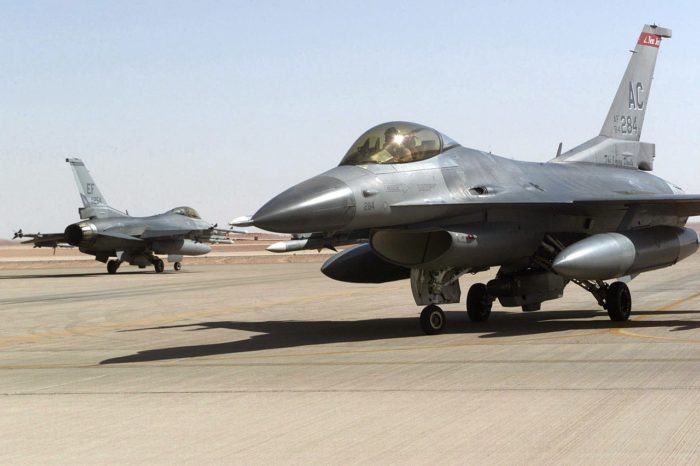
Credit: the United States Air Force.
Ukraine does not have an opportunity to use the air force for attrition warfare. The current inventory of the Ukrainian Air Force includes around 100 combat aircraft, according to open-source data.
According to open-source data, Russia has over 1,000 fighters, close-air support aircraft, and over 1,300 multi-mission, gunship, and attack helicopters.
However, neither side has air superiority due to the high saturation of air defense systems in the combat zone.
According to the Italian military expert Thomas C. Theiner, Ukraine replaced air power with Western long-range artillery systems and Storm Shadow missiles.
“Whereas in US and NATO operations, the sky is continuously swarming with fighters and bombers looking for enemy positions and vehicles to annihilate, all Ukraine has in the air are drones, which look for Russian equipment, ammo points, command centers, logistic points, etc.,” Thomas Theiner wrote on Twitter.
Ukraine extensively uses reconnaissance drones to track down Russian military equipment and manpower within artillery range. While Western fighter jets like F-16s can hit targets hundreds of kilometers deep behind the front lines, Ukraine is limited to the capabilities of its precision artillery and Western multiple rocket launchers like M142 HIMARS or M270A1 MLRS.

Ukraine’s Armed Forces have around 20 HIMARS that fire Guided Multiple Launch Rocket System (GMLRS) rockets within a range of 84 kilometers. HIMARS ammunition pods are interchangeable with M270A1 MLRS.
For long-range precision strikes, Ukrainian artillery relies heavily on M982 Excalibur artillery shells, which can hit targets within a range of 40 kilometers.
British long-range Storm Shadow cruise missiles can hit targets within a range of 250-500 kilometers. Still, it is unknown what modification of these missiles has been provided to the Ukrainian army (the export version of Storm Shadows can hit targets within a range of 250 kilometers).
Unlike aviation, the artillery, multiple rocket launchers, and even cruise missiles can only be used with precision to hit static targets.
To advance and break through multiple layers of Russian fortifications, Ukrainian forces must first degrade Russia’s heavy equipment and disrupt ground lines of communication. Attrition warfare takes much more time without aviation. Any territorial gains of strategic importance are impossible if this phase of the offensive is skipped.
According to Peter Greenburg, a former American F-16 fighter pilot, Ukraine desperately needs F-16 fighter jets to degrade Russian logistics and strike Russian supply routes from a distance.
“The transfer of F-16s to Ukraine will not be a panacea, but they will add new capabilities to the Ukrainian military, which would change the dynamics of the war and end it very quickly,” Greenburg said in his interview with the Radio NV.
According to the Atlantic Council, the F-16s will detect Russian aircraft at long distances, allowing Ukrainian pilots to stay out of Russian front-line air defense range.
The F-16 fighters that Ukraine is expected to receive from its Western allies will likely be equipped with AIM-120 AMRAAM air-to-air missiles, which are superior to the Russian Vympel NPO R-77 air-to-air missiles.
In addition, operating F-16s will provide Ukraine with a platform that can easily integrate a wide range of sophisticated weapons systems. This could include the AN/ALQ-131 electronic countermeasures system, long-range kinetic weapons such as the small-diameter bomb, and cruise missiles such as the AGM-158 JASSM, a long-range cruise missile with a 450-kg armor-piercing warhead. The operational range of AGM-158 is 370 kilometers.
Once Ukraine gets F-16 aircraft, the door will open for its Western allies to supply these weapons, as they are easily compatible with the F-16 fighters, according to the Atlantic Council.
Although Ukraine does not have Western fighter jets yet, the General Staff of the Ukrainian Armed Forces cannot afford to wait for new capabilities to arrive. It should conduct the counteroffensive relying on the resources it has at hand now. Time is one of the most significant factors the enemy can use to strengthen its defensive lines further and mobilize its resources.
Russian defense lines
The Russian army had enough time to prepare for the Ukrainian counteroffensive. According to the Financial Times, the construction of defensive lines on occupied Ukrainian territories began in November 2022 to entrench Russian troops.
Russia built multi-layered field fortifications inside Russian-occupied territory along the entire front line that spans nearly 2,000 kilometers from the Kherson and Zaporizhzhia oblasts in southern Ukraine to Belarus in the north.
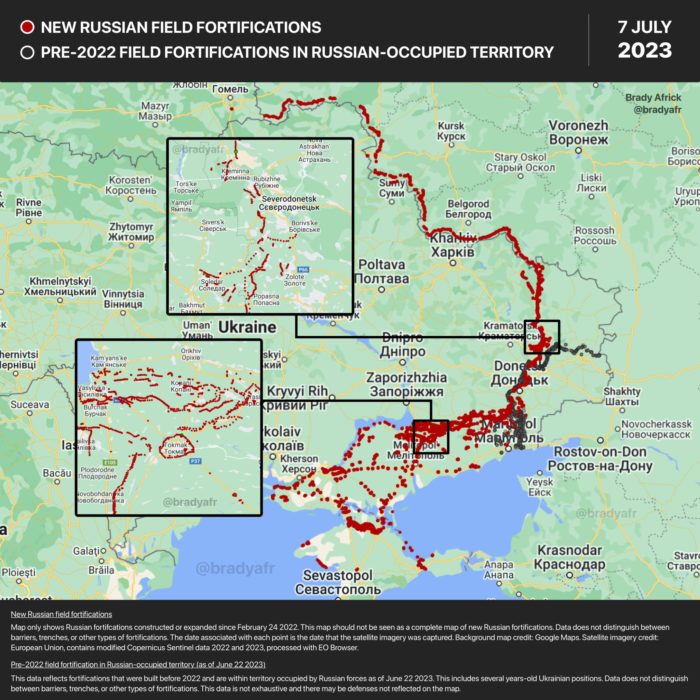
Map by Brady Africk.
Satellite imagery accessed from ESA’s Sentinel-2 data shows hundreds of kilometers of Russian trenches and revetments, lines of Dragon’s teeth (square-pyramidal anti-tank obstacles of reinforced concrete), and anti-vehicle ditches in the Zaporizhzhia Oblast, where Ukrainian forces try to advance from multiple directions.
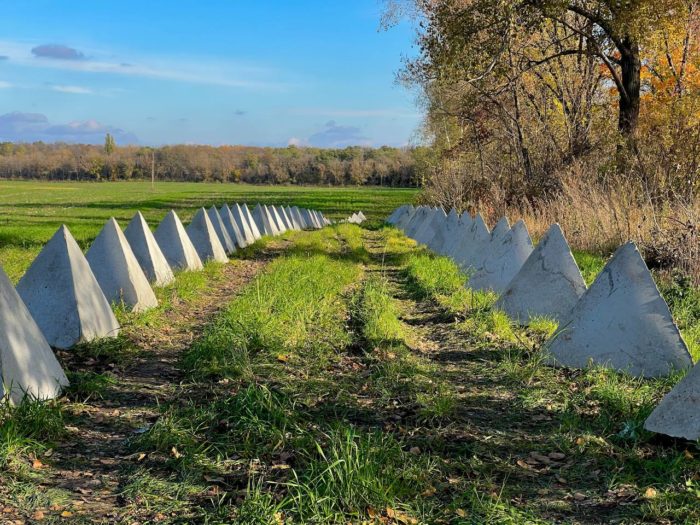
Credit: Militarnyi.
In the Zaporizhzhia Oblast, Russia constructed at least three fortified defensive lines. The first line of field fortifications spans around 150 kilometers from Vasylivka to Novopetrykivka on the border of the Zaporizhzhia and Donetsk oblasts. It contains multiple anti-tank barriers and infantry trenches backed by artillery positions located 30 kilometers behind the first line of defense.

Map by Deep State.
The second defensive line surrounds larger towns and is at least 130 kilometers long, stretching from Orlianske to Bilmak. This defensive line protects the Russian army against flank attacks and allows Russia to set up a new front if the Ukrainian forces breach the first defensive line.
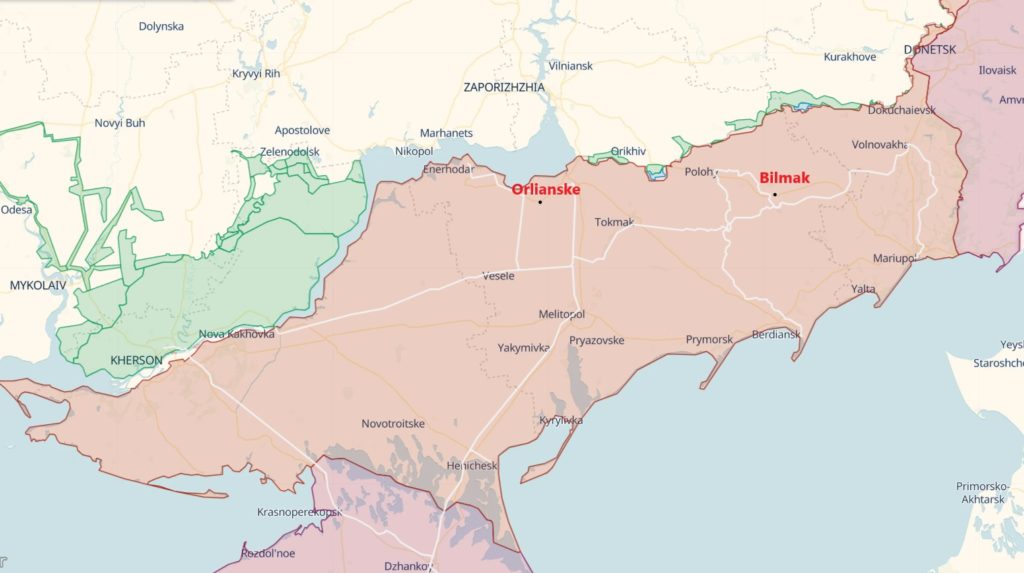
Map by Deep State.
The third line of defense is a constellation of strategically positioned fortifications, which should serve as a contingency to preserve Russian positions in case the Ukrainians get over the first two defensive lines. Thus, the Zaporizhzhia Oblast is Ukraine's most heavily fortified occupied region along the entire frontline. And this is the region where the Ukrainian counteroffensive is currently unfolding.
The Center for Strategic and International Studies described Russian field fortifications in occupied territories of southern Ukraine as the “most extensive defensive works in Europe since World War II.”
Even now, during the ongoing Ukrainian counteroffensive in the Zaporizhzhia Oblast, Russia continues to construct additional layers of defense in southern Ukraine, expanding defenses along roads leading south into occupied territory, according to OSINT analyst Brady Africk.
Behind all field fortifications, Russia prepared artillery positions to pound Ukrainian assault infantry and armor that tried to advance.

Whenever Russia lacks artillery capabilities to halt a Ukrainian advance, attack helicopters like Ka-52 are used to strike at Ukrainian troops. Before Ukrainian troops can even approach fortified lines of Russian defense, they must get over vast minefields.
"Areas between 5 and 16 kilometers deep in front of the Russian main strongholds have been densely mined with antitank and antipersonnel mines and trip wires. These defenses have slowed the Ukrainian advance,” unnamed Ukrainian soldiers told the Washington Post.
Ukraine was provided with less than 15% of the bomb disposal and engineering equipment it had requested from its Western partners, according to the Washington Post.
The areas in front of Russian defensive fortifications on the southern front (particularly in the Zaporizhzhia Oblast) are densely mined, which is one of the biggest obstacles to Ukrainian advance. The Russian army left narrow corridors free of mines to lure Ukrainian troops and hit the assault infantry and armor with artillery strikes.
Ukraine’s General Staff had to change tactics to deal with this challenge. Rather than trying to break through with the infantry fighting vehicles and main battle tanks that Western allies provided Ukraine with to support the counteroffensive, Ukrainian troops had to move forward slowly by foot, with sappers going first.
Grinding advance of the Ukrainian army
Before the counteroffensive, Ukraine received German-made Leopard main battle tanks, American-made Bradley armored fighting vehicles, German Marder infantry fighting vehicles, and other military equipment from Western allies. However, throwing all this armor against densely mined and heavily fortified areas under relentless artillery fire is not a great idea. Ukraine tried this approach during the early days of its counteroffensive on the southern front, but it did not work out well.
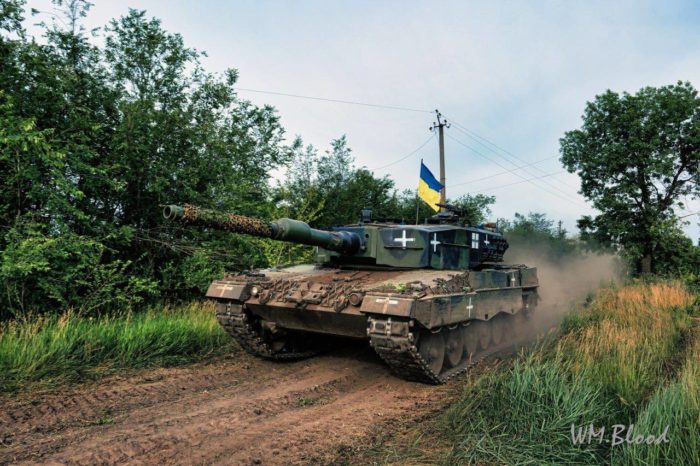
On 3 June 2023, when Ukraine’s summer offensive started, the Ukrainian 37th Marine Brigade managed to push Russian forces back near the settlement of Novodonetske on the border of the Donetsk and Zaporizhzhia oblasts in southeastern Ukraine. Artillery fire, armored personnel carriers, and tanks supported the Ukrainian attack. However, almost three months passed, and the Ukrainians made no significant advances in this area. Novodonetske is still under Russian control.
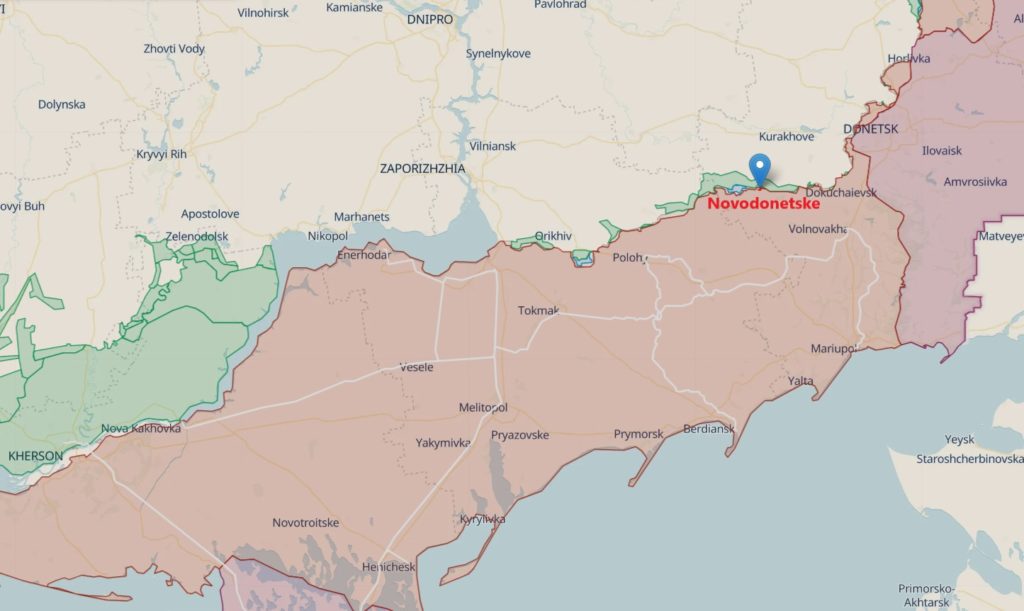
Map by Deep State.
On 4 June, Ukraine’s Armed Forces launched broader counteroffensive operations along the entire frontline in the Zaporizhzhia Oblast, trying to attack Russian positions from several directions simultaneously.
On 8 June, the Ukrainian attacks unfolded around the towns of Mala Tokmachka, Verbove, and Robotyne in the Zaporizhzhia Oblast. Although the Ukrainians managed to advance initially, the Russian army thwarted most attacks.
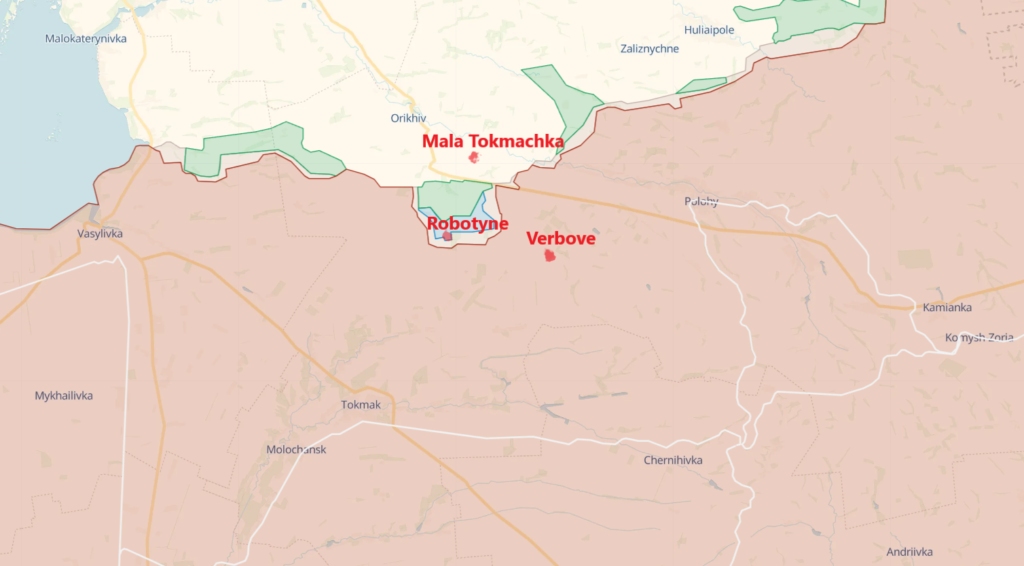
Map by Deep State.
The Russians pounded Ukrainian assault infantry, armored vehicles, and tanks using heavy artillery and attack helicopters. The Ukrainian offensive stalled and ran into a wall of dense minefields and intensive artillery fire.
Near Mala Tokmachka, the Ukrainian army first used and lost German-made Leopard main battle tanks and American-made Bradley vehicles, which were damaged and destroyed by the Russian artillery and mines. The footage of Western armor abandoned on the battlefield spread in the Russian media like wildfire.
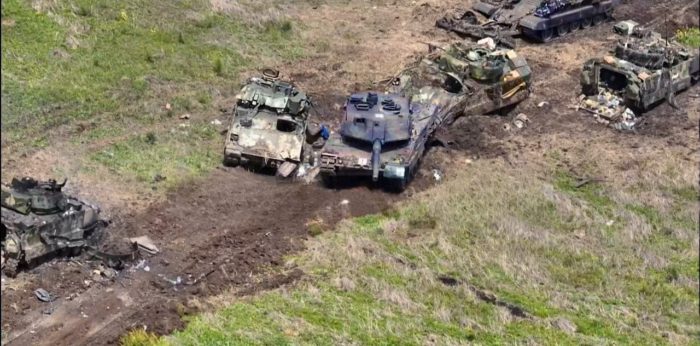
According to Forbes, during the summer counteroffensive, Ukraine lost five out of 71 Leopard 2 German-made main battle tanks supplied by the West. However, the setbacks of early June marked the change of tactics by the General Staff of Ukraine’s Armed Forces. The maneuver warfare has been supplemented by the attritional strategy, which entails constant Ukrainian strikes behind the frontlines and deep inside Russian-controlled areas.
At this stage of the offensive, Ukraine’s General Staff ensures its military forces are “in a good position for the tactical activity that achieves strategic outcomes,” according to the Australian strategist Mick Ryan.
“The cumulative effect of Ukrainian attacks on the Russian system will be aggregated and measured regularly,” Mick Ryan wrote on Twitter. “There will be a time when Ukraine assesses the Russian operational system has been sufficiently degraded, its ability to support tactical forces damaged and the ability to move reserves has been limited. This decision point will inform when large-scale ground combat begins.”
Ukraine’s Armed Forces have not yet deployed all of its strategic reserves for the counteroffensive. There are no signs that Ukraine has significantly ramped up the deployment of extra troops and equipment to the southern front.
A list of Western-supplied armor that has not yet been seen in combat includes American-made Stryker armored fighting vehicles (Ukraine has at least 157 Strykers) and many more. German-made Marder infantry fighting vehicles of the Ukrainian 82nd Air Assault Brigade (Ukraine was provided with at least 60 Marders), once held in reserve, have joined the counteroffensive on the southern front just recently, according to Forbes.

Marders of the 82nd Air Assault Brigade were spotted near Robotyne on 13 August. However, not all Ukrainian brigades prepared for the counteroffensive have already been committed to the battlefield. Ukrainian troops keep slowly but steadily advancing on the southern front despite holding some major units in reserve.
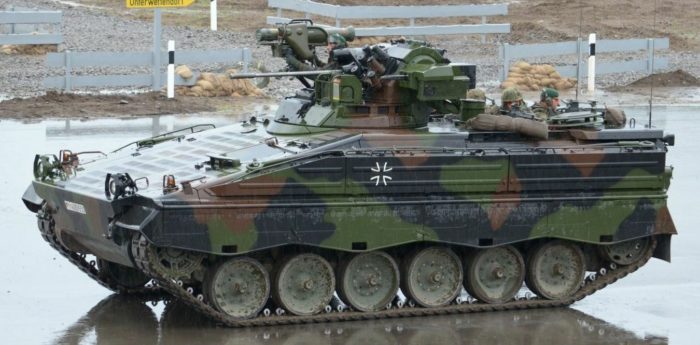
During the ongoing summer counteroffensive, Ukraine has already liberated 204,7 square kilometers of Russian-occupied territories, more than Russia captured in the entire 2023, according to Ukraine’s Deputy Defense Minister, Hanna Maliar.
On 27 July, Ukraine’s Armed Forces liberated the Russian stronghold in Staromaiorske on the border of the Donetsk and Zaporizhzhia oblasts and continued slowly moving forward down south from several directions: near Piatykhatky and Zherebianky (Zaporizhzhia Oblast) towards the intersection of important supply routes in Vasylivka (namely the highways P37 and M18), near Robotyne close to the first line of the Russian defense towards the city of Tokmak, a key logistic hub in the Zaporizhzhia Oblast, and near Staromaiorske and Pryiutne towards tactically important heights in Staromlynivka.
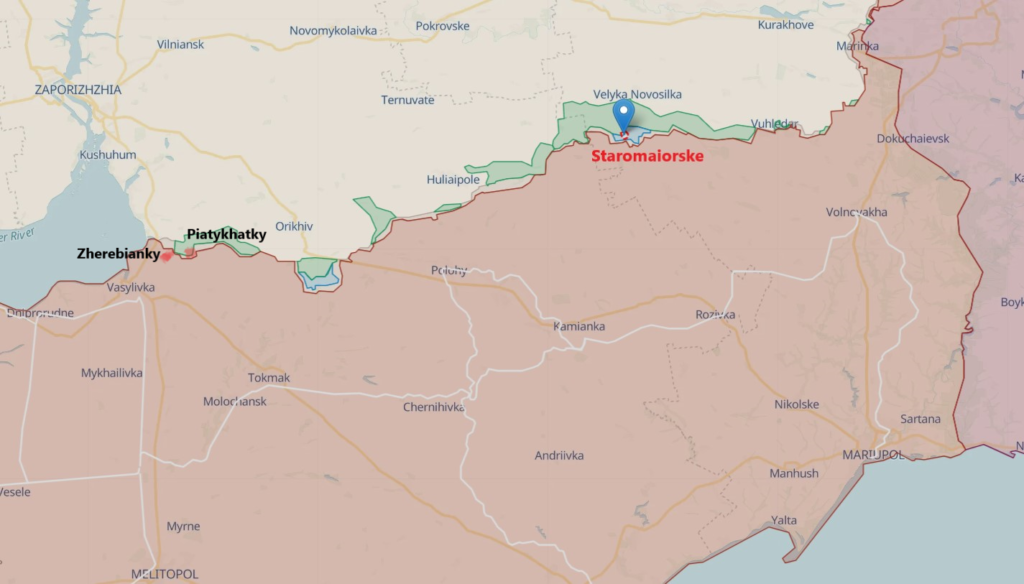
Map by Deep State.
On 8 August, Serhii Kuzmin, a representative of the Tavria Operational and Strategic Group of Ukraine’s Armed Forces (southern front), claimed that Ukrainian troops overcame Russian minefields and reached the first line of Russian defense in the Zaporizhzhia Oblast.
On 16 August, Ukraine’s Armed Forces liberated Urozhaine, a Russian-occupied village on the border of Donetsk and Zaporizhzhia oblasts in southeastern Ukraine. Russian troops retreated down south to their stronghold in Staromlynivka (Donetsk Oblast), which is a vital transportation hub with an intersection of important highways: T0518, leading southward, and T0814, leading westward to Robotyne.
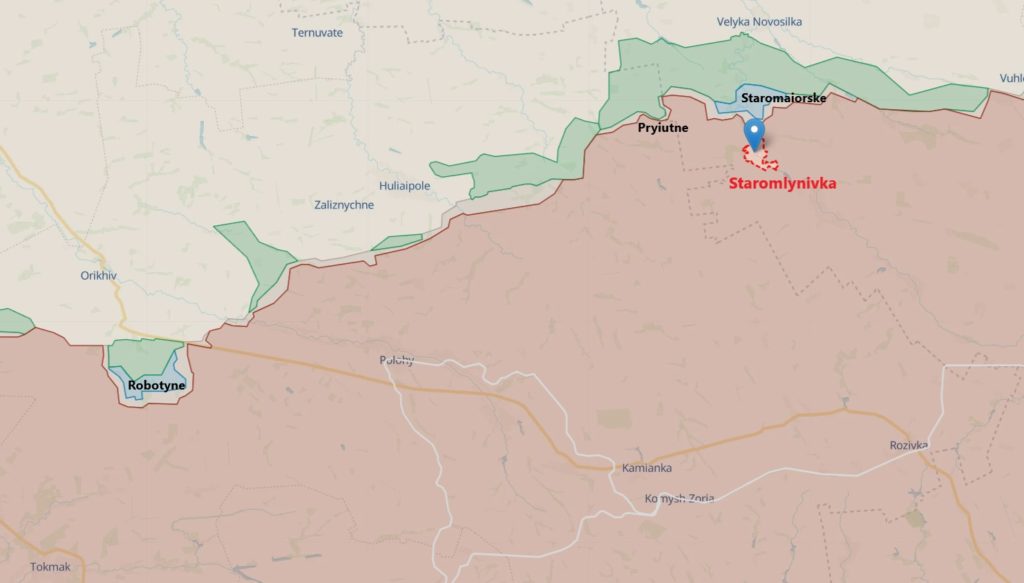
Map by Deep State.
On 22 August, Ukraine’s Deputy Defense Minister, Hanna Maliar, announced that the Ukrainian 47th Mechanized Brigade entered Robotyne.
According to the Bild reporter Julian Röpcke, the Ukrainians have already pushed the Russians out of Robotyne and gained control of the entire town.
https://twitter.com/JulianRoepcke/status/1693898854532329840
Robotyne, a town that Russian forces turned into a stronghold, is located near the first line of the Russian fortifications in the Zaporizhzhia Oblast. To reach Robotyne, Ukrainian troops had to get over kilometers of dense Russian minefields. The liberation of Robotyne would mean that the first Russian defense line out of three was likely breached.
Advancing in this area allows Ukrainian forces to begin operating beyond the densest of the Russian minefields that have held up the counteroffensive all summer long, the ISW reported.
The territory between the first and the second lines of Russian fortifications in the Zaporizhzhia Oblast may not contain such dense minefields as those that Ukrainian troops overcame on the way to Robotyne. The Russians had to leave mine-free areas to be able to move between the first and the second defensive lines.
Thus, after Robotyne is liberated, the advance of Ukrainian forces further south may accelerate. The distance between Robotyne and occupied Tokmak, a vital logistics hub of the Russian forces, is around 23 kilometers. If Ukrainian troops advance any further, Tokmak will be within reach of Ukrainian precision artillery strikes, which may significantly disrupt Russian logistics on the southern front.
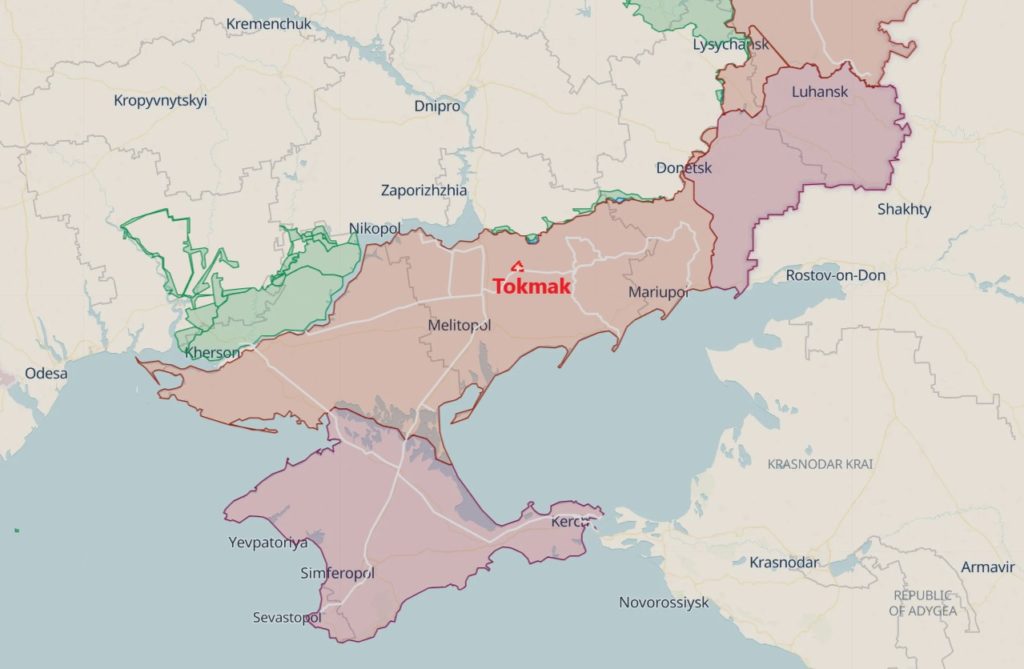
Map by Deep State.
During the summer counteroffensive on the southern front, Ukraine’s Armed Forces have already liberated the following towns:
- Blahodatne, Neskuchne, Makarivka (all in Donetsk Oblast, liberated on 11 June);
- Storozheve (Donetsk Oblast), Novodarivka, Lobkove, Mali Shcherbaky, Levadne (all in Zaporizhzhia Oblast, liberated on 12 June);
- Piatykhatky (Zaporizhzhia Oblast, liberated on 19 June);
- Novopil, Rivnopil (Zaporizhzhia Oblast, liberated on 26 June);
- Staromaiorske (Donetsk Oblast, liberated on 27 July);
- Urozhaine (Donetsk Oblast, liberated on 16 August);
- Robotyne (Zaporizhzhia Oblast, liberated on 22 August).

Map by Deep State.
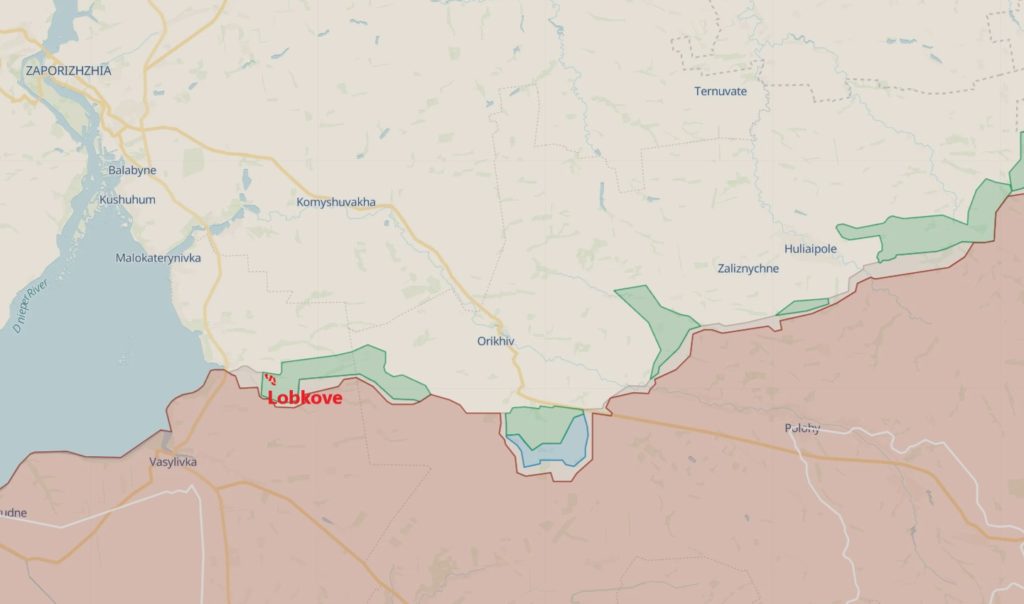
Map by Deep State.
Apart from advancing in the Zaporizhzhia Oblast, the Ukrainian Army conducts operations in other areas of southern Ukraine.
Ukraine’s Special Operations Forces managed to cross the Dnipro River and create a small bridgehead on the eastern bank of the occupied Kherson Oblast near Oleshky, south of Kherson city. Despite Russian strikes on the concentration of Ukrainian troops in that area, the Ukrainians did not budge. They maintained their presence in the small town of Dachi on the island between the Dnipro and Konka rivers (83 kilometers from Crimea).
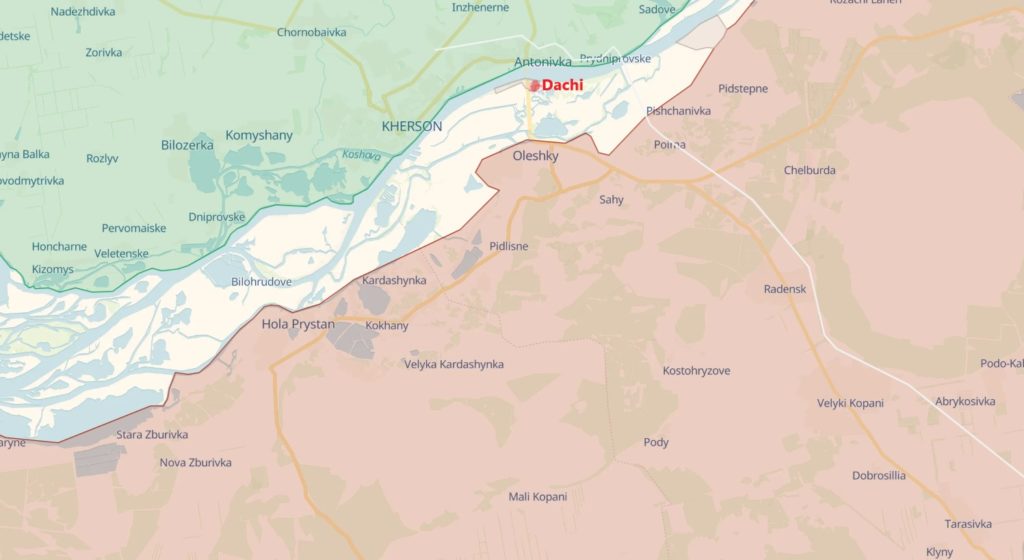
Map by Deep State.
Although, at this point, it is unlikely that the Ukrainians can deploy armored vehicles across the Dnipro River and significantly enlarge their bridgehead on the eastern bank, the presence of Ukrainian troops in Dachi is supported by intense artillery fire from Ukraine's Armed Forces.
Ukrainian soldiers raised the Ukrainian flag on Dnipro island between Kherson and Russian-occupied Oleshky
They also showed how the flooding and Russian shelling damaged the area and played the national anthem of Ukraine while raising the flag. https://t.co/St7bsBllwB pic.twitter.com/U6kXrN900c
— Euromaidan Press (@EuromaidanPress) August 29, 2023
Apart from Dachi, Ukraine’s Special Forces carried out an amphibious landing near Kozachi Laheri, another town on the eastern bank of the occupied Kherson Oblast, which some Russian military bloggers confirmed.
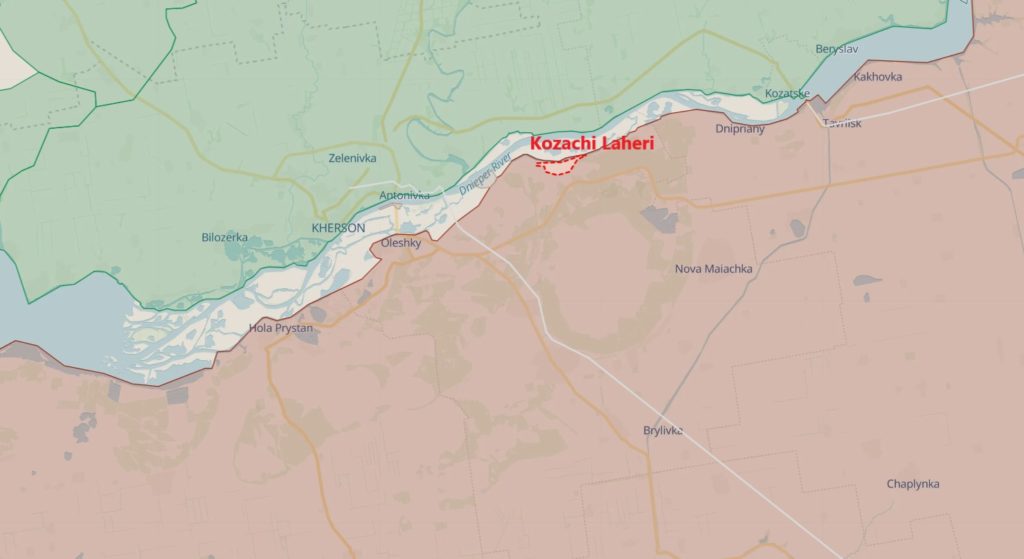
Map by Deep State.
Russia’s General Staff cannot afford to ignore the activity of the Ukrainian Army in that area. Russia has not created heavily fortified multilayered defense lines in the Kherson Oblast, unlike the occupied part of the Zaporizhzhia Oblast.
Thus, if Ukraine manages to deploy mechanized brigades to the eastern bank of the Dnipro River, Ukrainian forces will penetrate the rear of the Russian grouping in southern Ukraine, which could lead to the collapse of the southern front.
Considering that the Kakhovka reservoir has dried out dramatically following the Kakhovka dam destruction in June 2023, the possibility of deploying more Ukrainian troops on the eastern bank across the Dnipro River cannot be discounted by the Russian military command.
https://twitter.com/EuromaidanPress/status/1687040039409111041
The activity of Ukrainian troops at the mouth of the Dnipro River and the creation of bridgeheads on the eastern bank forced the Russian military command to send reinforcements to the Kherson Oblast. According to Kostiantyn Mashovets, a military analyst of the Information Resistance (a Ukrainian OSINT group), the Russian General Staff has already deployed the newly formed 70th Motorized Rifle Division from occupied Crimea to the Kherson Oblast.
In addition to raids on the eastern bank of the Dnipro River, Ukraine’s Armed Forces intensified their activity in occupied Crimea. Ukraine uses kamikaze drones and British long-range Storm Shadow missiles to strike Russian command posts, ammunition dumps, airfields, and military bases in occupied Crimea almost daily.
On 23 August, an explosion in the village of Olenivka on Cape Tarkhankut in occupied Crimea destroyed the Russian long- and medium-range S-400 Triumph air defense missile system, Ukraine’s intelligence (GUR) reported, publishing a video of the explosion.
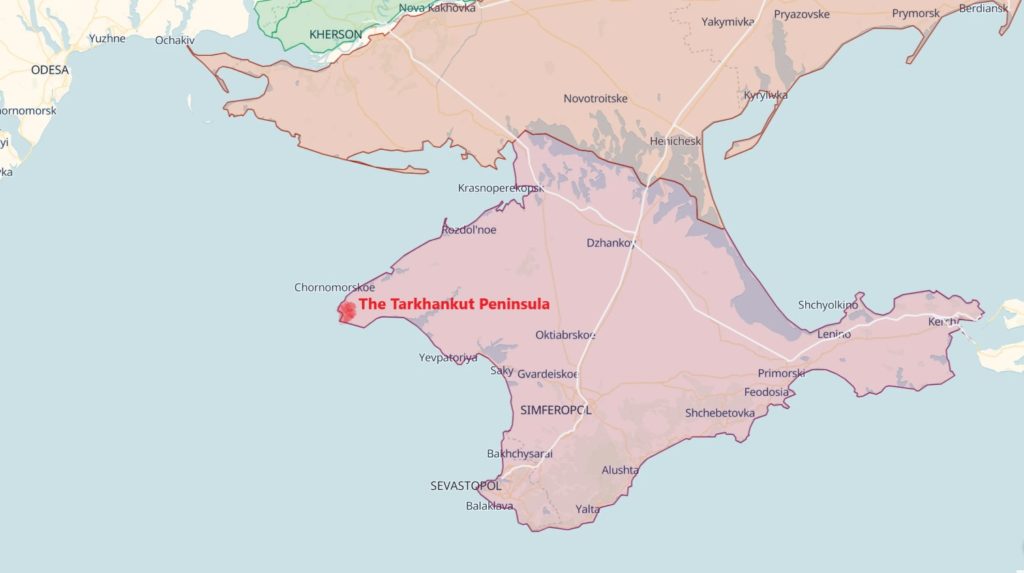
Map by Deep State.
“Given the limited number of such systems in the enemy's arsenal, this is a painful blow to the occupiers' air defense system, which will have a serious impact on further events in the occupied Crimea,” the Ukrainian intelligence said in its statement on 23 August.
https://twitter.com/EuromaidanPress/status/1694546822499389559
A day later, on 24 August, the Ukrainian Special Operations Forces carried out an amphibious landing in the Tarkhankut Peninsula of occupied Crimea, Ukraine’s intelligence (GUR) reported, publishing several videos of the operation. This was the first amphibious landing of Ukrainian troops on the territory of Crimea since Russia occupied it in 2014.
The liberation of Crimea, which seemed absolutely impossible just a year ago, depends on whether Ukraine can liberate the Zaporizhzhia Oblast, where the Ukrainian counteroffensive is gaining momentum now.
Before the next offensive phase can begin, Ukraine must degrade Russian heavy equipment, especially the firepower system. The only way to do that is to lure Russian forces into the range of HIMARS strikes and precision-guided artillery shells by attacking the Russian defensive lines, which is exactly what the Ukrainian army is doing.
According to Thomas Theiner, the Russian military command faces a dilemma: either to deploy reserves and bring heavy equipment forward to halt Ukrainian attacks or allow Ukrainian troops to advance. To avoid any breakthrough, the Russians bring their heavy equipment forward within the range of the Ukrainian artillery and multiple rocket systems, which Ukraine exploits to relentlessly hit the Russian firepower system.
The Ukrainian army is also taking casualties, luring the Russians out. However, the number of losses on the Russian side shows that the Ukrainians are succeeding in wearing down Russian artillery, air defenses, and armor, which are being hit methodically.
Abnormal losses
to Phillips O'Brien, an American historian and professor of strategic studies at the University of St. Andrews (Scotland), the Ukrainian counteroffensive is still in the “destruction phase.” It is yet to move to the operational maneuver.
At this stage, the Ukrainian military command focuses on neutralizing Russian artillery.
“The focus on Russian artillery is clear from Ukrainian claims of destruction. Basically, the daily rate in the last few weeks is almost 200% larger than it has been over the last 500 days. That does not happen by accident,” Phillips O’Brien wrote in his article about the Ukrainian counteroffensive. “They [the Ukrainians – ed.] will probably stay on that for a while. When they feel they have done what they can here, they will switch to attacks on Russian forces in the lines. This will take time — even months. Because war is so dangerous for the offensive side, and Ukraine does not want to waste its forces like the Russians did at Bakhmut, for instance, they must proceed methodically to weaken the Russians before advancing. It is also the only Ukrainian option —because of the specific way that they have been armed.”
According to the Ukrainian General Staff, the losses of Russian self-propelled and towed artillery have soared dramatically in the summer of 2023. Ukrainian forces destroy dozens of Russian artillery systems every day (based on data published by Ukraine’s General Staff in its daily updates).
Oryx, a Dutch open-source intelligence monitoring group that documents Ukrainian and Russian military equipment losses based on photo and videographic evidence, confirms that Russian artillery losses have increased during the Ukrainian counteroffensive in June, July, and August 2023 compared to previous months of Russia’s invasion.
To replace the loss of firepower, Russia uses attack helicopters Ka-52 that pound Ukrainian infantry and armor within a range of ten kilometers from the frontlines. Since Ukraine lacks air power and anti-aircraft systems like an American-made AN/TWQ-1 Avenger self-propelled surface-to-air missile system, Russian attack helicopters severely threaten Ukrainian infantry, armor, and demining vehicles.
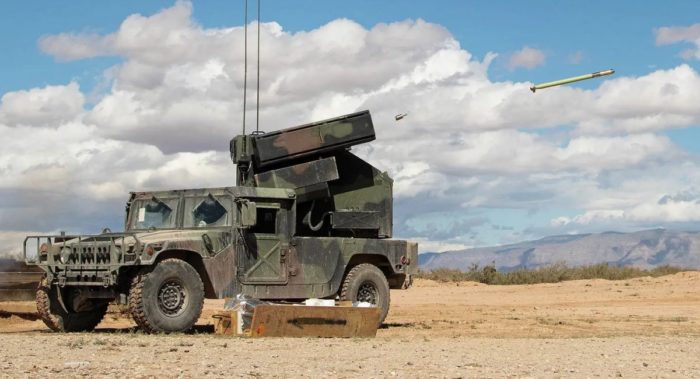
Credit: Defense Express.
According to Reuters, Washington has supplied at least 12 Avenger systems to Ukraine. The Avenger is a rotating turret with eight missiles mounted on the back of a Humvee, making it highly mobile and effective weaponry to counter Russian attack helicopters armed with anti-tank missiles launched from a distance of 7-10 kilometers from the frontline.
Although Ukrainian troops have managed to take down several Russian helicopters on the southern front within the last few months using Starstreak MANPADS (a British short-range surface-to-air missile that can be used as a man-portable air defense system), Russian attack helicopters (along with mines and artillery) are causing significant damage to Ukrainian mechanized brigades.
According to the New York Times, Ukraine lost as much as 20 percent of its weapons and armor deployed to the battlefield during the summer counteroffensive.
However, Russia also suffers heavy losses. According to Jakub Janovsky, an OSINT analyst (Bellingcat and Oryx contributor), Russia loses dozens of pieces of equipment daily. For instance, on 16 August alone, Ukraine destroyed, damaged, or captured at least three Russian tanks and ten infantry fighting vehicles, destroyed five Russian air defense systems (namely two S300V4 launchers, two 9S32M1 air defense radars, and Pantsir S1 air defense system), and at least four Russian self-propelled artillery systems, based on the video and photo evidence.
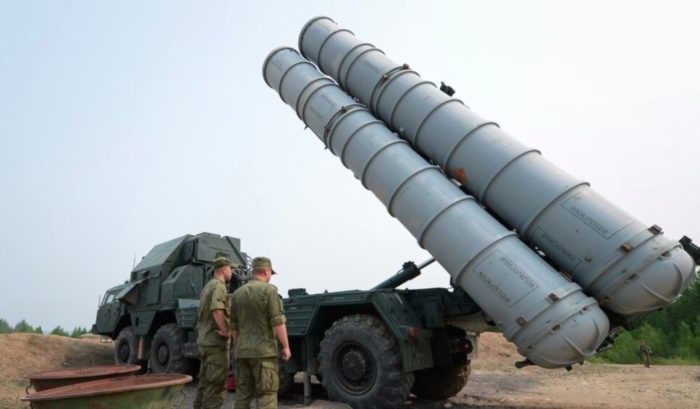
In August, Russia lost 668 artillery systems (while the average rate of losses is about 290 Russian artillery systems per month), according to Ukraine’s General Staff.
The ratio of armor losses on the Russian and Ukrainian sides is roughly one-to-one, which is quite unusual because Ukraine is on the offensive. According to the theory of warfare, the attacking side is supposed to suffer at least three times as many casualties as the defending side, which is not the case with the Ukrainian offensive due to the peculiarities of its operational design that relies on attritional strategy.
Besides targeting Russian military equipment, Ukraine actively uses Western newly supplied cluster munitions to eliminate Russian manpower entrenched in multilayered defensive lines.
The United States gave Ukraine an unknown amount of dual-purpose improved conventional munitions (DPICM) to strike at Russian infantry and armor. A DPICM is an artillery or surface-to-surface missile warhead designed to burst into submunitions at an optimum altitude and distance from the desired target for dense area coverage.
According to Def Mon, an OSINT analyst, the Russian Army keeps counter-attacking the advancing Ukrainian forces instead of falling back to the prepared defensive lines, which, along with the effective use of DPICM cluster munitions, leads to high attrition of the Russian Army on the southern front.
On 18 August, the Russian Army Colonel, Piotr Shuvalov, confirmed that Russian troops suffered heavy casualties due to the extensive use of Western cluster munitions by the Ukrainians. Russia should have done its best to block the supply of Western cluster munitions to Ukraine, Shuvalov wrote on Telegram.
However, despite heavy attrition of Russian equipment and manpower, it is still unclear whether Ukraine’s Armed Forces can build momentum, the senior research fellow for land warfare at the Royal United Services Institute, Jack Watling, wrote in the Financial Times.
According to Jack Watling, just like Ukraine, Russia is also adjusting its tactics to inflict maximum damage on the Ukrainian Army.
"Russian forces allow the Ukrainians to enter minefields and then aggressively counterattack, often with tanks and anti-tank guided guns on their flanks. Once the Ukrainian vehicles are knocked out, the Russians use mortars and artillery against the infantry. If the Ukrainians overcome minefields and get into trenches, the Russians often abandon their fighting positions and detonate preplaced charges to destroy the first wave of attackers," Jack Watling wrote.
Ukraine has suffered significant losses after initial attempts to breach the minefields and has adapted its tactics. According to Jack Watling, Ukrainian troops infiltrated Russian positions to confuse the Russians and strike from the flanks before attempting a breakthrough. Such tactics reduced Ukrainian casualties but slowed the advance.
In response, Russia has to act more aggressively with its armored vehicles, deploying them close to the front line, which makes this equipment vulnerable.
Annihilation of Russian firepower
According to Oryx, Russia lost far more artillery systems during the Ukrainian army's summer offensive than Ukraine. Ukraine uses Western-supplied artillery systems to degrade Russian firepower and strike targets within a longer range than its Russian counterparts, making it hard for Russia to effectively employ its counter-battery warfare capabilities.
Oryx recorded more than 174 visually confirmed losses of the Russian 152-mm self-propelled howitzers MSTA-S, but the actual number is higher. In addition to combat losses, howitzers are lost due to worn-out barrels and expired engines. Moreover, not all howitzers in service are in good condition. Thus, the lower limit of losses of MSTA-S (the most widespread Russian self-propelled howitzer) is about 20%, according to the Ukrainian OSINT group Viyskovyi Vishchun.
https://twitter.com/EuromaidanPress/status/1668921470670499840
These are significant losses, which the Russians are compensating for by using less long-range but more powerful 240-mm Tyulpan (Tulip) self-propelled heavy mortars and by decommissioning the 152-mm 2S5 Giatsint (Hyacinth) self-propelled howitzer similar to the Msta-S howitzers.
In the past few months, the number of destroyed Tyulpan self-propelled heavy mortars has soared, which may indicate the Russian effort to compensate for the loss of long-range artillery with more powerful systems to hold back the advance of the Ukrainian Army on the southern front.

The main storage site for Tyulpan self-propelled heavy mortars is the 94th arsenal in Omsk (eastern Russia). There were up to 200 units at this site in 2021. Satellite images show a decrease in the number of Tyulpans by about 30 units (equipment is regularly moved around the base), according to Viyskovyi Vishchun.
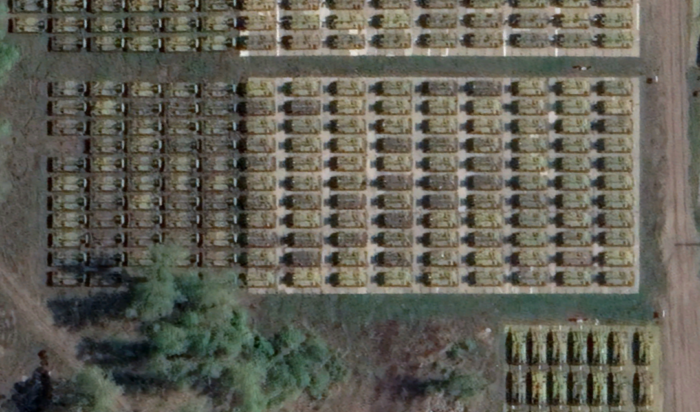
Credit: Viyskovyi Vishchun.
The other 176 Tyulpans are located at another site. As of May 2023, the number of Tyulpans at that site decreased by about 70 units, according to satellite imagery.
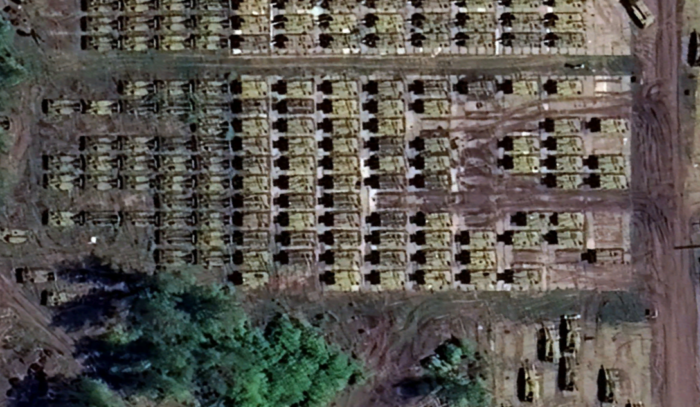
Credit: Viyskovyi Vishchun.
The Tyulpans, decommissioned and thrown into combat, began to be targeted more often this summer. As of today, the confirmed losses of Tyulpans alone amount to 20 units, according to Oryx. Currently, there may be from several dozen to a hundred Tyulpans in service in Ukraine. Up to 200 units are still in storage in Russia, according to Viyskovyi Vishchun.
On top of Tyulpans, Russia loses a lot of 152-mm self-propelled howitzers 2S5 Giatsint that the Russian Army uses extensively to compensate for the losses of MSTA-S self-propelled howitzers.
According to The Military Balance, Russia had at least 100 2S5 Giatsint self-propelled howitzers in service and 850 in storage at the beginning of the full-scale Russian invasion of Ukraine.
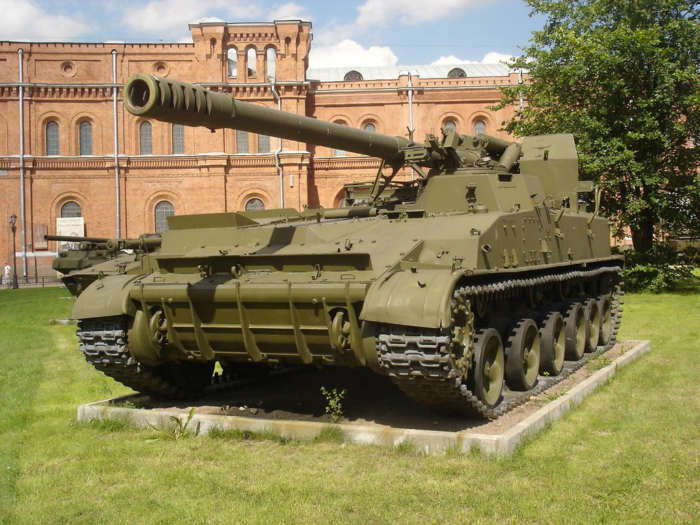
Credit: Viyskovyi Vishchun (illustrative photo).
Confirmed losses of Giatsint howitzers amounted to 40 units, according to Oryx, which is almost 50% of all Giatsints that Russia has in service.
Satellite imagery shows that Giatsints are being removed from storage in Russia en masse. A large number of 2S5 Giatsint self-propelled howitzers are stored at the 94th arsenal in Russia’s Omsk. In 2021, there were 108 pieces of equipment at this site. In May 2023, there were only 38 units left there, according to Viyskovyi Vishchun.
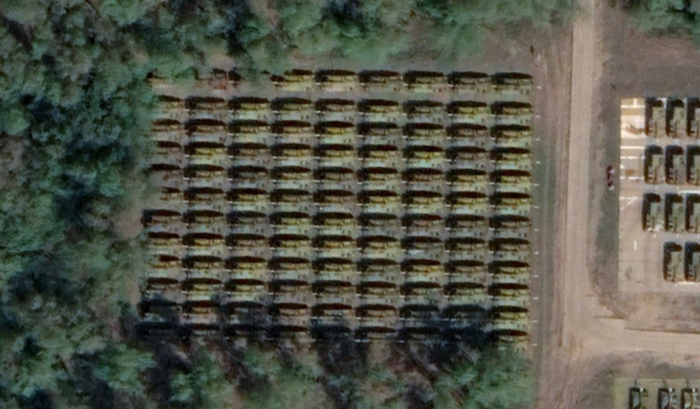
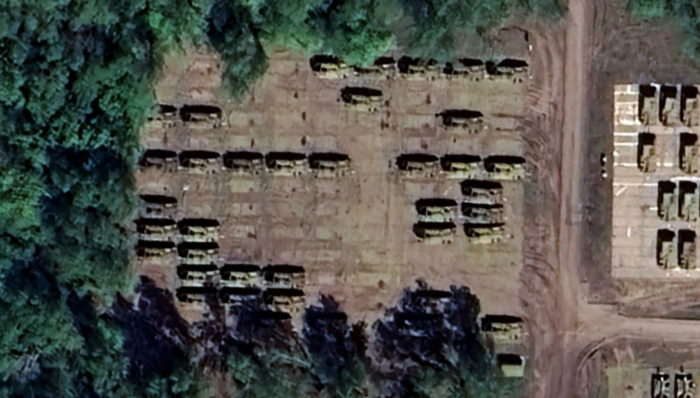
Credit: Viyskovyi Vishchun.
The second site in Omsk housed 91 Giatsints. In 2023, the number decreased by 30-40%. Thus, Russia has already taken out of storage at least half of the 200 2S5 Giatsint howitzers in Omsk.

Credit: Viyskovyi Vishchun.
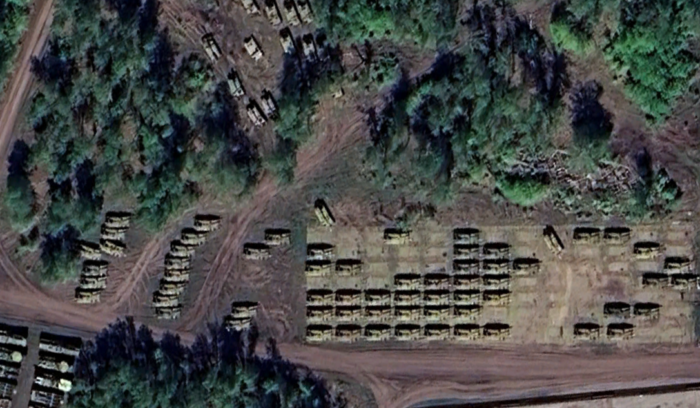
Credit: Viyskovyi Vishchun.
In 2021, 36 2S5 Giatsint howitzers were stored at the 120th arsenal in Bryansk (western Russia). Satellite images show that in 2023, all of those Giatints were taken out of storage.

Credit: Viyskovyi Vishchun.

Credit: Viyskovyi Vishchun.
Furthermore, over 50 Giatsints are in storage in Ussuriysk (Russian Far East), more than half of which have been removed from storage.
Another 36 Giatsints were stored at a storage base in Buryatia (eastern Russia). As of May 2023, only six were left.
As of May 2023, more than 200 Giatsint self-propelled howitzers can be visually confirmed to have been taken out of storage, according to satellite imagery. The same number is visually in storage.
Apart from Giatsints, Russia extensively uses modernized 2S7 Malka and Pion self-propelled 203-mm cannons. According to The Military Balance, Russia has 60 2S7 Malka cannons in service and 260 Pions in storage.

Credit: Viyskovyi Vishchun (illustrative photo).
So far, the confirmed losses of Russian 203-mm cannons are 14 units, according to Oryx. These are long-range systems that are not so easy to hunt down.
Russia also lost 130 152-mm 2S3 Akatsiya self-propelled howitzers, according to Oryx. Active counter-battery warfare is a critical component of the Ukrainian counteroffensive. Although Russia has a massive stockpile of Soviet artillery systems, even these stockpiles are being degraded fast.

Credit: Wikipedia (illustrative photo).
Due to the high intensity of hostilities, howitzer barrels are also damaged and get out of order. It must be noted that Russia fires more shells daily than Ukraine does.

Credit: Visyskovyi Vishchun.
One way or another, the life of Russian artillery systems is not infinite. If the fighting in Ukraine remains as intense as it is now, Russian artillery systems can start getting out of order en masse in a year, according
to Viyskovyi Vishchun.
Russia indirectly confirmed that the loss of artillery systems on the southern front was out of control and could have irreversible consequences for Russia's ability to defend the occupied territories. Russian Major General Ivan Popov, commander of the 58th Army, was dismissed following a report to the head of Russia’s General Staff, Valery Gerasimov.
In his statement, Popov mentioned significant losses on the southern front, where the 58th Army is dealing with the ongoing Ukrainian counteroffensive. Later, in his audio message that leaked online, General Popov stated that in his report to Valery Gerasimov, he mentioned the “catastrophic” failure of the Russian Army to provide effective counterbattery fire and significant losses of Russian artillery systems on the southern front due to highly effective counterbattery measures of Ukrainian artillery.
According to Ukraine’s General Staff, Russia lost a record-high number of artillery systems in July alone: 677 units. This is more than twice as much as Russia's monthly losses since the beginning of its full-scale invasion in February 2022. In August, Russia lost 668 artillery systems, according to Ukraine’s General Staff.
Such an attritional approach of Ukraine’s General Staff over the past three months is a part of shaping operations that prepare the battlefield for the next wave of Ukrainian counteroffensive when the bulk of Ukraine’s strategic reserves would be used to break through Russian defensive lines.
Along with artillery, Russian anti-aircraft systems are also among the top-priority targets for the Ukrainian Army. Russia lost a record-high number of air defense systems in June (56 units). In July, the losses of Russian air defense systems set a new record. Russia lost 73 anti-aircraft systems in July alone, the Ukrainian military analyst Oleksandr Kovalenko reported, based on an estimate of Russian military equipment losses provided by the Ukrainian General Staff.
In August, Russian losses of anti-aircraft systems reached 38 units, according to the data provided by Ukraine’s General Staff.
Significant Russian losses of air defense systems on the southern front allowed Ukrainian kamikaze and reconnaissance drones to infiltrate the Russian rear, hit Russian artillery systems and armor, and coordinate precision artillery strikes.
It is hard to say when the Ukrainian General Staff decides that the depletion of Russian firepower is complete and the battlefield is shaped for another round of Ukrainian advance and maneuver warfare. Currently, the attritional phase of the Ukrainian counteroffensive is in full swing. Although the bulk of Ukrainian strategic reserves are yet to be committed, the steady advance of the Ukrainian forces continues. The Ukrainian Army is approaching the second line of the Russian defense in the Zaporizhzhia Oblast.
The high rate of destruction of Russian artillery reduces the ability of the Russian army to resist Ukrainian attempts to break through the fortified frontlines. The dry weather will allow Ukraine to continue offensive operations until early November when the rainy season usually begins in Ukraine.
Ukrainian strikes at Russian logistics
“Infantry wins battles, and logistics wins wars." This quote by US Army General John J. Pershing, commander of the American Expeditionary Forces in World War I, summarizes why logistics is so important. This is certainly a principle that Commander-in-Chief of the Armed Forces of Ukraine Valerii Zaluzhnyi adheres to.
Apart from degrading Russian artillery and air defense systems, Ukraine strikes targets deep inside Russia and occupied territories on a daily basis. The operations of the Ukrainian Army to destroy Russian military targets in the rear of the occupied territories (especially in Crimea, Kherson, and Zaporizhzhia oblasts) led to a significant deterioration in the logistics of Russian troops. Ukrainian strikes deep into the Russian-controlled territories reduced Russia's ability to conduct combat operations on the southern front, according to the Institute for the Study of War (ISW).
Ukraine’s military officials confirm that a systematic campaign against Russian ammunition dumps, command posts, and concentration of equipment and manpower in Russian rear areas degrades Russian logistics and counterbattery capabilities of Russian artillery, which contributes to “an asymmetrical attrition gradient in Ukraine’s favor,” ISW reported.
Ukraine uses HIMARS, kamikaze drones, and British long-range Storm Shadow missiles to destroy Russian ammunition dumps, concentration of troops and equipment, oil depots, and command posts deep inside Russian-controlled territories. Ground lines of communication remain one of the primary targets for Ukrainian long-range strikes that aim to disrupt Russian logistics.

Russian military logistics relies heavily on railroads and is highly vulnerable to Ukrainian attacks. Moreover, the railroad system in the occupied territories of Ukraine’s South is quite limited.
To supply its troops in southern Ukraine, Russia can only use the railway from the Krasnodar region in southwestern Russia that leads to southern Ukraine via the Kerch Bridge in occupied Crimea through the Chonhar Bridge in the Kherson Oblast and via Armiansk in the northern part of Crimea (the railroad through Armiansk is going to Kherson, which is under Ukrainian control). Another option to supply Russian troops on the occupied territories of southern Ukraine is to use the railroads from Russia to the occupied Luhansk and Donetsk Oblasts.

Credit: Ukrzaliznytsia.
The only problem with this route is that it is cut off by the Ukrainian artillery fire in Volnovakha (Donetsk Oblast). No trains can go through this area down south to the Zaporizhzhia Oblast.

Map by Deep State.
Since Russia cannot use this route, the Kerch Bridge (or Crimean Bridge) and Chonhar Bridge remain critical for Russian logistics in southern Ukraine. These are the bridges that Ukrainian strikes have already damaged several times.

Map by Deep State.
The first strike on the Crimean Bridge on 8 October 2022 featured a truck with explosives expertly wrapped in plastic film. Ukraine struck the Crimean Bridge for the second time on 17 July 2023, using maritime kamikaze drones. Although Russia can still employ the railroad across the Crimean Bridge, the car traffic is limited due to the previous damage caused by Ukrainian attacks.
The Chonhar Bridge that connects occupied Crimea with the occupied Kherson Oblast in southern Ukraine was first damaged by a Ukrainian strike (allegedly a Storm Shadow missile strike) on 22 June 2023. On 29 July, a missile strike again damaged the railroad bridge in Chonhar. On 6 August, Storm Shadow missiles hit the automobile bridge in Chonhar and the bridge at Arabat Spit, which was used by cars to enter the Kherson Oblast from Crimea.

Map by Deep State.
Currently, all of these bridges either do not function or have limited capacity that does not allow them to be used for the transportation of multi-ton military cargo. Instead of the bridges in Chonhar and at Arabat Spit, Russia has to rely on the road through Armiansk to supply its troops in Kherson and Zaporizhzhia oblasts. The detour from Armiansk to the Zaporizhzhia Oblast, where the Ukrainian counteroffensive is ongoing, slows down the supply of Russian troops with ammunition and fuel needed to repel Ukrainian attacks.

Map by Deep State.
As a result of accurate long-range strikes, Ukraine’s Armed Forces have significantly disrupted the logistics and ammunition supply of Russian forces in southern Ukraine.
According to Natalia Humeniuk, Chief of the Unified Coordination Press Center of the Southern Defense Forces, Russian forces suffer from a severe shortage of munitions.
"We continue to target and destroy their [Russian - ed.] depots and supply lines, preventing them from replenishing their depleted resources. The ammunition depots they [the Russians - ed.] had set up on the Dnipro River's left bank [eastern bank - ed.] have already been neutralized. Their efforts to reinforce them are becoming increasingly challenging," Natalia Humeniuk said.
Igor “Strelkov” Girkin, a retired Russian Federal Security Office who took part in the Russian invasion of Ukraine in 2014, slammed Russian military command for failing to protect ground lines of communication. Girkin claimed that “Ukraine’s tactics aimed at isolating the battlefield in the South” would inevitably lead to the withdrawal of Russian troops from the entire Zaporizhzhia Oblast in the autumn of 2023 and the cut-off of the so-called Russian land bridge (the logistical route from Russia to Crimea via Donetsk, Zaporizhzhia, and Kherson oblasts). Arrested by Russian authorities, Girkin is now in jail on charges of discrediting the Russian army.
Ukrainian strikes on Russian logistics are not limited to occupied territories of Ukraine. Ukraine extensively uses long-range kamikaze drones to strike Russian military airfields, oil depots, and other military infrastructure inside Russia, including the Russian capital, Moscow, attacked by drones 17 times this summer.
On 19 August 2023, a Russian Tu-22M3 fighter was highly likely destroyed at Soltsy Airbase in Russia’s Novgorod region, more than 650 kilometers from the Ukrainian border.
Ukrainian attacks on the Russian rear are becoming more frequent and significantly impact the balance of power on the battlefield in Ukraine.
Phases of Ukrainian counteroffensive: What is next?
According to Anders Puck Nielsen, a Royal Danish Defense College military analyst, the Ukrainian counteroffensive has four distinct phases.
Stages of the Ukrainian counteroffensive:
- The first phase: maneuver warfare
- The second phase: attrition of the Russian artillery
- The third phase: attrition of the Russian manpower
- The fourth stage: return to maneuver warfare
The first phase was the initial attempt at maneuver warfare in June 2023, when the Ukrainian Army used tanks and infantry fighting vehicles to attack Russian positions in the Zaporizhzhia Oblast, according to Anders Puck Nielsen. During this phase, Ukraine suffered heavy losses due to dense Russian minefields, intensive artillery fire, and air strikes. Ukraine’s General Staff quickly changed tactics and moved to the second phase, which entailed attrition of the Russian artillery. And this is the phase we are in right now, Anders Puck Nielsen noted.
After Ukraine’s Armed Forces pushed the Russians out of their stronghold in Robotyne in Zaporizhzhia Oblast and allegedly broke through the first line of the Russian fortified defense in that area (out of three defensive lines), the advance of the Ukrainian forces further south may become faster compared to the previous months. The densest Russian minefields were likely on the approaches to the first line of Russian defense.
Ukrainian forces are steadily moving forward to the occupied city of Tokmak, which is around 23 kilometers south of Robotyne. Tokmak is a vital logistics hub. If Russia loses it, the so-called land bridge from Russia to occupied Crimea will become vulnerable. Although the Russians constructed layers of fortifications between the occupied cities of Polohy and Tokmak, the question is whether Russia has enough reserves to repel the Ukrainian advance if the Ukrainian troops break through the second Russian defensive line.
Under the increasing pressure from Ukrainian troops, at some point, Russian infantry may find themselves scattered in a thin line along the stretched front. Without sufficient artillery fire and support of armored vehicles, the Russian defenses may start crumbling. The weather may allow Ukraine to build up pressure and push forward until late October or early November. This is when the rainy season begins in southern Ukraine, making it impossible for Ukrainian mechanized brigades to advance over muddy terrain.
Thus, Ukraine’s General Staff has two months to achieve the strategic goals of its counteroffensive on the southern front, which include
- Taking control of Tokmak, Melitopol, Berdiansk and Mariupol (vital logistic nodes in southern Ukraine)
- reaching the strategically important Azov Sea coastline
- cutting off the so-called land bridge and isolating occupied Crimea.
In his conversation with US officials, Ukraine’s Commander-in-Chief, General Valerii Zaluzhnyi, said that Ukrainian forces are close to breaking through Russia's defenses on the southern front, the Wall Street Journal reported on 24 August.
Ukraine's Armed Forces need a steady supply of precision artillery shells and DPICM cluster munitions from Western allies to keep moving forward. The attrition of the Russian artillery, frontline air defense systems, and armor, constant Ukrainian strikes on the Russian ground lines of communication, ammunition dumps, and command posts, combined with the lack of Russian reserves, could help accelerate the advance of Ukrainian forces on the southern front in autumn. The next phase of the Ukrainian counteroffensive may be just around the corner. The success of this phase may put significant territorial gains for Ukraine on the map.
If the Russian defensive lines on the southern front collapse within the next few months, the Ukrainian Army will reach the Azov Sea and cut off the Russian land bridge in southern Ukraine. In this case, the next wave of Ukrainian counteroffensive could use Crimea's isolation to liberate the peninsula from which the Russian war against Ukraine began in 2014.
Russia is putting up fierce resistance to stop the ongoing Ukrainian counteroffensive on the southern front because what is at stake is not Tokmak, Melitopol, or Mariupol. It is Crimea. Russian control of the Crimean peninsula undermines Ukrainian security for decades to come and makes a new attack on Ukraine possible in the future.
Related:
- ISW: Ukrainian troops approach Russian second line of defense in Zaporizhzhia Oblast
- Frontline report: Ukraine shows potential of Crimea's liberation by conducting drone attacks, landing ops
- Ukrainian counteroffensive: What is going on?
- Let’s not create a high expectations trap as to where Ukraine would advance soon, Bielieskov says





